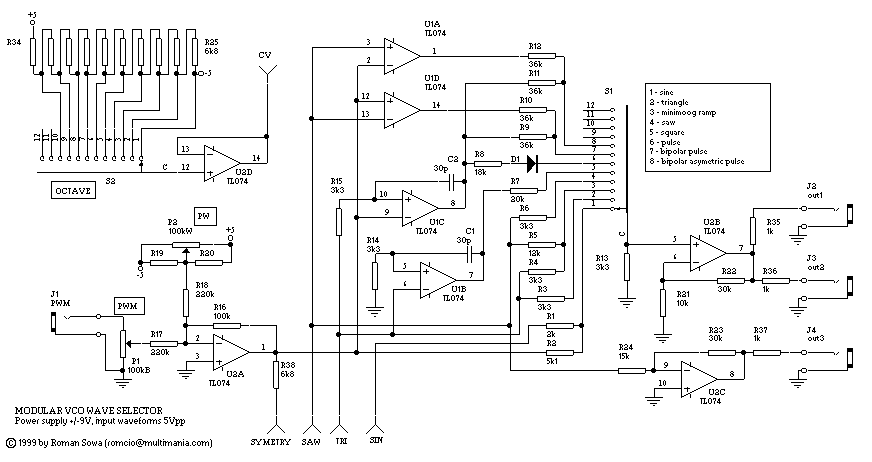Quad
VCO
This is part of my new project (or rather two
similar ones) which is Analog Modular Synth. More to come soon.
It was inspired by many projects seen on synth-diy mailing list
and is one of very few using SSM2164 as a core element (I
personally don't know any other). If you have any questions
regarding this project, don't hesitate to ask me.

See larger photo of the board
Go and see scope screen shots
of waveforms up to 120kHz
- Specifications
- Frequency range: 0.003Hz - 120kHz
Waveforms: sawtooth (ramp up and down), triangle
and something like sine
- Power supply: +/- 9V (or 12 if you like) +1V,
and reference voltages.
- Board dimensions: 10x12cm
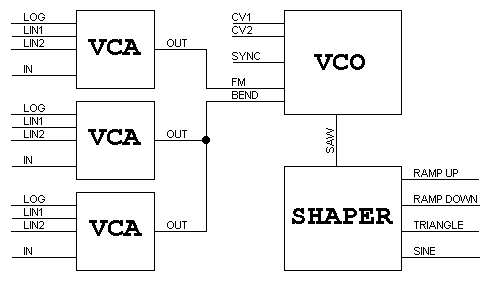
- Description
- The above diagram shows one of the four identical VCOs.
All are built using one SSM2164. This makes them easier
to keep in constant intervals over temperature.
- 3 modulation VCAs for each VCO gives 12 (!) of them - a
lot to solder. Each VCO has two V/oct inputs and other
two VCA attenuated. One VCA is for linear FM input.
- Fortunately those 4 oscillators run independently, i.e.
some of them (but not all) will sync only when they are
real close tuned - say about 1kHz, beating slower than
0.1 Hz.
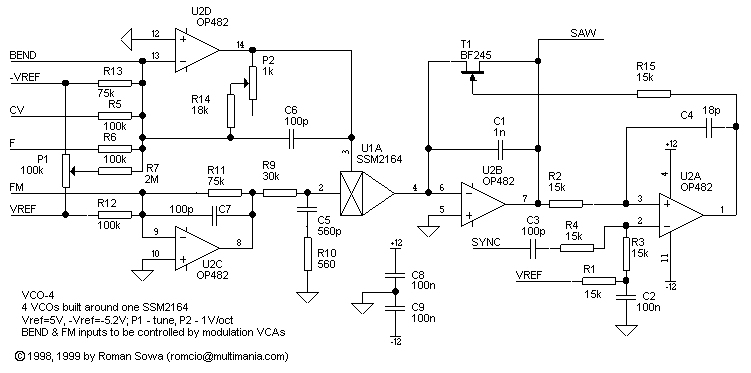
- VCO core
- Nothing unusual. U1A serves as exp. converter and current
source. Integrator U2B with 1nF poly-something cap is
reset by T1 FET when saw voltage reaches Vref (+5V). Sync
pulses affect this voltage, so ramp is reset sooner and
we get something like soft-sync.
- P2 determines U2D gain to set 1V/oct relation. P1 is for
fine tuning.
- OP482 may be replaced by TL074. BF245 resets the
integrator to about 0.2V. I've tried BS250 instead and it
clamped to 0V, but the saw was more distorted.
- BEND is current input for pitch modulation
(input from VCA)
- VREF is temperature compensated reference
voltage set to +5V
- -VREF is another reference voltage delivered
from VREF by inverting amplifier, and is -5.2V.
- CV and F are 1V/oct inputs
- FM is an input from linear-FM VCA
- SAW goes to waveshaping part of the circuit
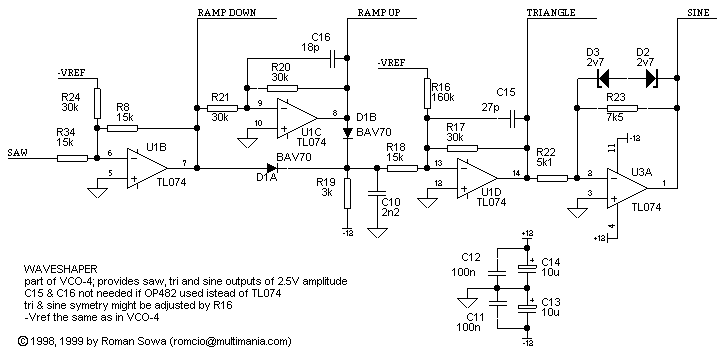
- Waveshaping
- Rather complicated rectifier, but gives nice triangle. It
also gives bipolar (DC removed) sawtooth (up and down)
and kinda like sine wave shaped by zener diodes.
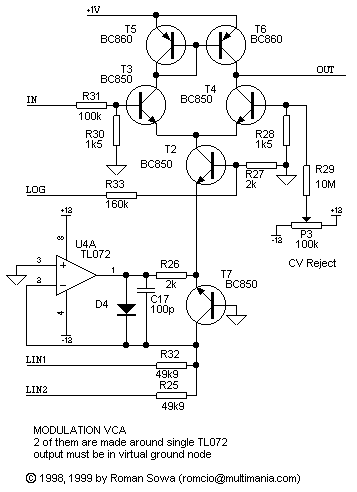
- Modulation VCA
- Frequency may be modulated via VCAs, which are standard
discrete circuits. The current mirror is powered from
just only +1V to prevent it from self-heating. I didn't
select any of these transistors, but they seem to have
similar parameters on tape.
- LOG is exponential control voltage input
- LINx are linear control voltage inputs.
- Wave selector
- For Modular Classic I need +/-5V output
waveforms, and also square ones would be usefull. that's
why 'wave selector', which is 8-position rotary switch
routing specified waveform to panel output jack
-
Three VCO's waveforms: sine, triangle and saw are formed in
opamp-resistors network to maintain 2.5Vpp amplitude for every
selected waveform. Amplifier U2B makes +/-5V otput out of it.
Third output is hardwired to saw of oposite direction than from
wave selector output (i.e. it's ramp up while out1 and out2
can provide ramp down). U2A attenuates PWM signal down to
+/-2.5V, drives pulse comparators, and via R38 resistor changes
sine shape (goes to inverting input of U3A in waveshape section) to make wave shaping similar to one used in Synthi.
See also the photo of wave selector
HOME
Copyright 1999 Roman Sowa
Last revised: March 9th 1999





